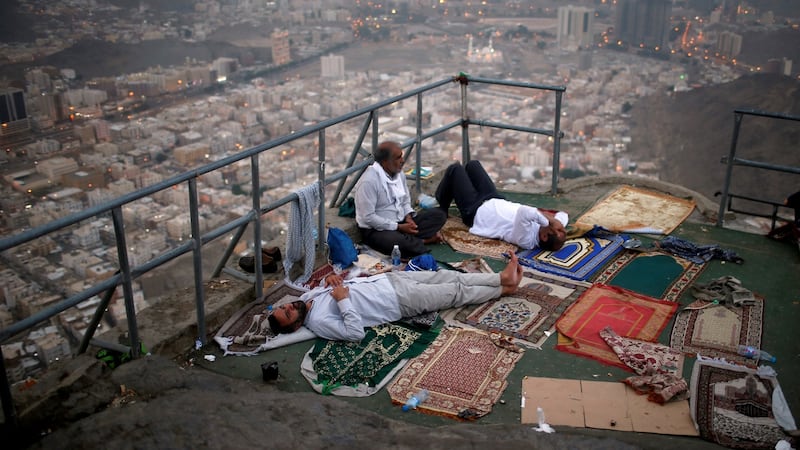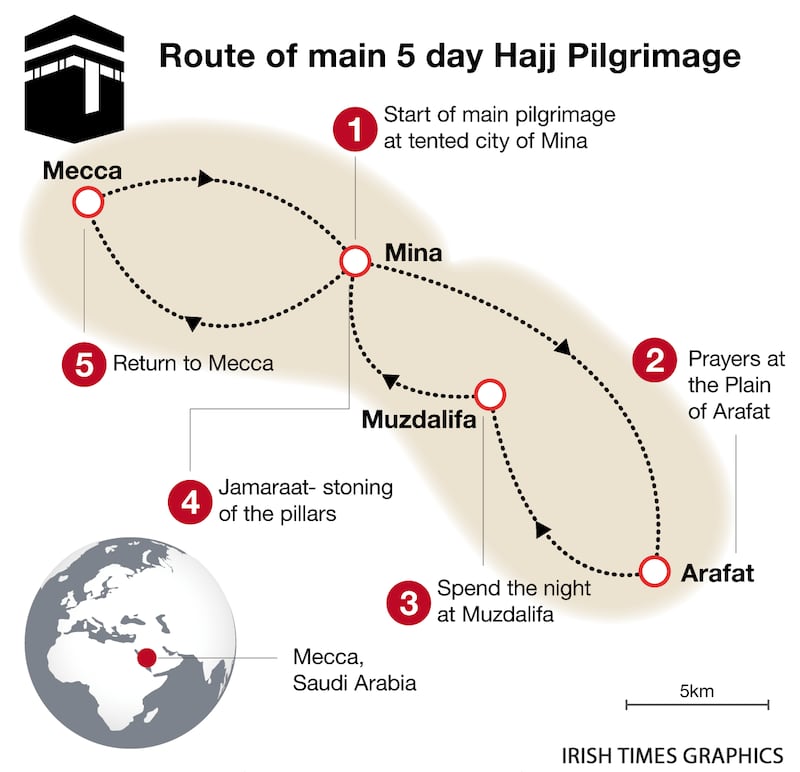Nearly two million pilgrims on Wednesday celebrate the joyous feast that is the culmination of the annual hajj, although more than a dozen of their number have died from heart attacks while performing this year’s sacred journey.
Ibu Mariah Marghani Mohamed, from Indonesia, the oldest pilgrim at 104, was asked to obtain a certificate of good health before attempting the hajj, an arduous event due to crowding and temperatures which rise to 40 degrees.
Some 1.7 million hajjis have travelled by air, land and sea to Saudi Arabia from 80 countries around the world; another 200,000 reside in the kingdom. Under a quota system 221,000 Indonesians, 179,000 Pakistanis, 170,000 Indians, 79,000 Turks and 86,500 Iranians are among the nationalities that have secured hajj visas; 1,200 Qataris are also attending, although Saudi Arabia and the emirate are currently at odds.
Since Riyadh has no diplomatic relations with Damascus, Syrians have to obtain visas from third countries. At least 1,000 Palestinians belonging to families who have lost members in clashes with Israelis have arrived from Gaza as guests of Saudi King Salman.
As “custodian” of the cities of Mecca and Medina, the Muslim holy sites, the king should not bar Muslims from performing the hajj, one of the five pillars of Islam. However, thousands of “illegals” who have arrived without visas have been turned away. There are hundreds of thousands on waiting lists.
Saudi Arabia has deployed 100,000 security personnel to keep order, prevent political protests, and ensure the safety of the pilgrims. Stampedes, fires, demonstrations and violence have, over the years, led to thousands of deaths. The latest disaster was in 2015 when more than 2,000 were crushed to death.
Some 51,000 civilian employees provide essential services. A fleet of ambulances has been deployed, 30,000 health workers are on duty, and 5,000 hospital beds have been made ready. Many pilgrims are elderly and ailing and believe it is a blessing to die on the hajj.
Ahead of the pilgrimage, several cases of Middle East respiratory syndrome coronavirus (MERS) were reported and the World Health Organisation has warned of cholera. Since 2012, more than 1,700 people have contracted MERS in Saudi Arabia, of whom 691 have died, while there is a deadly outbreak of cholera in neighbouring Yemen where Saudi Arabia is waging war on rebels.
Over the five-day period, pilgrims shelter in two vast tent cities, receive water, and three meals a day. Ritual sites are connected with a network of highways, tunnels and flyovers. Traffic is managed so they reach specific sites in time to perform rites and prayers, according to a schedule set by the Prophet Muhammad, his family and Companions when they made the hajj in 632 AD.

Pilgrim management is a major issue and is largely left to contracting firms. Pilgrims are generally grouped by nationality. Sunnis and Shias are separate as they have their own clerics and traditions.
Although the hajj is attended by thousands of educated people who need little assistance, tens of thousands are illiterate rural villagers and townspeople who speak only local languages, have rarely left home, are bewildered by travel and frightened by the vast throng.
Pilgrims wear bracelets denoting the agency they are travelling with in case they get lost. Many are also ignorant of the rites of the pilgrimage and have to be shepherded from prayer to prayer as well as from place to place.
The hajj is not as large as Indian Hindu pilgrimages, but is the most multicultural and multinational religious event in the world.

The hajj: a typical pilgrimage
The pilgrimage begins in Mecca with rituals which date to the time of Abraham and involves a journey along a valley that stretches 13km east of the holy city.
Pilgrims wear “ihram”: men are attired in two seamless cloth wraps, women in white caftans and headscarves, faces uncovered.
The first stage of the journey is to Mina, 6km from Mecca. En route, pilgrims chant, “Here I am, O God, at Thy Command!” At Mina, they settle into a vast air-conditioned tent city, their base for the next four or five days. They pray, meet friends and wander the streets.
The next day the multitude is transported 7km to the Plain of Arafat where another vast tent city has been erected. A few hundred climb to the summit of Mount Arafat, from where the prophet delivered his final sermon, all join a vigil, and face the mount in commemoration of this event. At dusk, pilgrims move to the plain of Muzdalifah where they worship, sleep and gather pebbles to pelt three pillars representing the “devil” .
At dawn they return to Mina where they stone the first pillar before celebrating the Feast of Sacrifice to mark Abraham’s sacrifice of a sheep rather than his son. Prosperous pilgrims purchase sheep for sacrifice and give portions of the meat to the poor.
Pilgrims move to Mecca to complete hajj rituals before returning to Mina for the stoning of the other two pillars over the next two or three days.
The pilgrimage ends in Mecca with the circumambulation of the Kaaba, the symbolic house of God at the centre of the Grand Mosque. Either before or after the pilgrimage most hajjis visit Medina, the city ruled by the prophet for 10 years and the location of his tomb.











